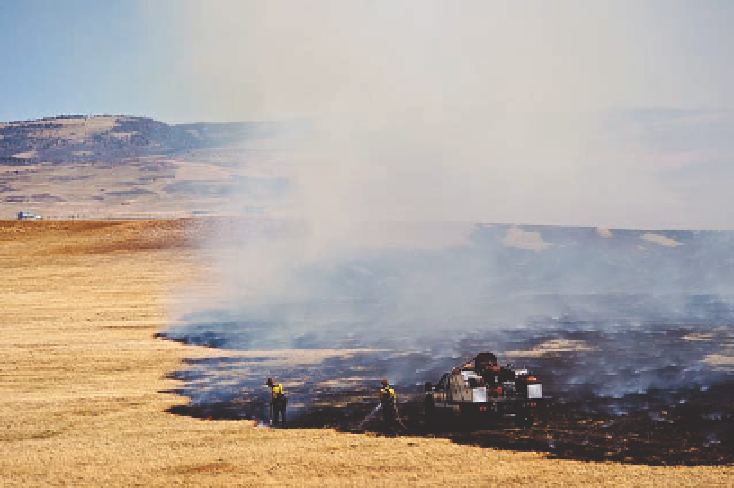Geoscience Reference
In-Depth Information
Fig. 6.11. Late-summer fire in the
mixed-grass prairie of the Laramie
Basin. Fires in tallgrass prairies are
less easily extinguished. Photo by Ken
Driese.
Generalizations about the effects of fire on specific
plants are difficult, but warm-season species seem to
have evolved a higher level of tolerance for burning
than cool-season species, probably because they are
more likely to be growing in the drier summer months
when most fires occurred. Some species increase in
abundance after fires, not because fires are directly
beneficial, but because additional water and nutrients
become available following the death of less-tolerant
species, or because a more favorable environment for
their growth is created by the burning of mulch on the
soil surface.
58
Fires also affect nutrient cycling and plant growth.
in some cases plant growth following fire is faster, with
greener, more palatable nutrient-rich stems and leaves.
Burned grasslands initially appear black and totally dev-
astated, but in a few weeks it is common to see herds of
bison, pronghorn, and cattle grazing on the regrowth.
indeed, indians probably burned grasslands intention-
ally to attract game to smaller areas, where they could
be more easily harvested. the animals would have been
lured by more nutritious forage, resulting from the sud-
den availability of nutrients after accumulated mulch
was burned. combustion, like microbial decomposi-
tion, converts organic matter to the inorganic nutrients
needed for plant growth.
Another effect of burning, especially in taller grass-
lands, is to remove the insulating mulch, allowing the
soil to warm up and plant growth to begin earlier in
the spring, when water is available. Very little nitrogen
is lost to the atmosphere by burning, compared to the
amount that remains in grassland soils. Furthermore,
the amount lost is replaced in a few years by precipita-
tion (see fig. 6.6).
Because of these influences, total plant growth is
sometimes higher after a fire, at least in relatively moist
prairies with tall grasses, such as in central and east-
ern nebraska and in eastern Kansas. this observation
has led some managers to encourage the burning of
grasslands as a regular practice. However, mixed-grass
and shortgrass prairies in the West are more frequently
water stressed than tallgrass prairie, a condition that
could be aggravated by fire because of increased evapo-
ration from the warmer, blackened surface.
59
the effects of grazing and fire on plant growth are
interactive. Grazing can be so intense that there is little
mulch left on the soil surface, which leads to lower flam-
mability. if, however, a large amount of mulch accumu-
lates due to fire suppression or very little grazing, then
much of the water in short summer showers can be
intercepted by the mulch and evaporated without ben-
efiting the plants at all. Such adverse impacts may be
offset to some extent by the increased trapping of snow
by the accumulated biomass and less evaporation from
the shaded soil surface, but this beneficial effect is not
known to happen regularly.

Search WWH ::

Custom Search